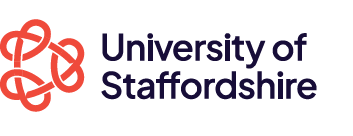Module Descriptors

RECORDING STUDIO PRODUCTION
MUSI40600
Key Facts
Digital, Technology, Innovation and Business
Level 4
30 credits
Contact
Leader: David Hickman
Email: D.Hickman@staffs.ac.uk
Hours of Study
Scheduled Learning and Teaching Activities: 72
Independent Study Hours: 228
Total Learning Hours: 300
Assessment
- Coursework - group DAW project 1 with written report (1000 words) weighted at 50%
- Coursework - development of group DAW project 2 with individual written technical report (1500 words) weighted at 50%
Module Details
INDICATIVE CONTENT
Key studio and Digital Audio Workstation principles and techniques
Strategies for working in professional recording studio environments
Processing audio with hardware and software
Editing and arranging digital audio and MIDI
Sound and recording fundamentals
Mixing and mastering principles and techniques
Strategies for working in professional recording studio environments
Processing audio with hardware and software
Editing and arranging digital audio and MIDI
Sound and recording fundamentals
Mixing and mastering principles and techniques
LEARNING STRATEGIES
3-hour laboratory / lecture / tutorial sessions per week
RESOURCES
Music recording studios
Media stores / resource centre
Music laboratories
Avid Pro Tools software
Apple Logic software
Ableton Live software
Adobe Audition software
Cycling 74 Max software
Hexedit software
Various additional third-party audio plug-ins by McDSP, Avid, Eventide, Michael Norris.
Microsoft Office software
Books, eBooks and audio recordings via the Library
Lynda.com Training library
Online hosting (e.g. Soundcloud) and transfer (e.g. WeTransfer) services
Media stores / resource centre
Music laboratories
Avid Pro Tools software
Apple Logic software
Ableton Live software
Adobe Audition software
Cycling 74 Max software
Hexedit software
Various additional third-party audio plug-ins by McDSP, Avid, Eventide, Michael Norris.
Microsoft Office software
Books, eBooks and audio recordings via the Library
Lynda.com Training library
Online hosting (e.g. Soundcloud) and transfer (e.g. WeTransfer) services
TEXTS
Bartlett, B. & Bartlett, J. (2012). Practical Recording Techniques: The Step- by- Step Approach to Professional Audio Recording. 6 edition. Waltham, MA: Focal Press.
Huber, D.M. & Runstein, R.E. (2005). Modern recording techniques. Boston: Focal Press/Elsevier.
Izhaki, R. (2012). Mixing audio: concepts, practices and tools. London: Focal.
Rumsey, F. & McCormick, T. (2014). Sound and Recording: Applications and Theory. 7 edition Burlington, MA: Focal Press.
Snoman, R. (2013). Dance Music Manual: Tools, Toys, and Techniques. 3 edition. Burlington, MA: Focal Press.
Huber, D.M. & Runstein, R.E. (2005). Modern recording techniques. Boston: Focal Press/Elsevier.
Izhaki, R. (2012). Mixing audio: concepts, practices and tools. London: Focal.
Rumsey, F. & McCormick, T. (2014). Sound and Recording: Applications and Theory. 7 edition Burlington, MA: Focal Press.
Snoman, R. (2013). Dance Music Manual: Tools, Toys, and Techniques. 3 edition. Burlington, MA: Focal Press.
LEARNING OUTCOMES
1. RECORD AND PROCESS DIGITAL AUDIO USING SUITABLE HARDWARE AND SOFTWARE
[Knowledge and Understanding]
2. APPLY EFFECTS, DYNAMICS PROCESSORS AND EQUALISATION TO AUDIO.
[Problem Solving]
3. DEMONSTRATE AN UNDERSTANDING OF THE SCIENTIFIC AND MATHEMATICAL PRINCPLES AND PRACTICALITIES OF THE NATURE OF SOUND WITH REGARD TO SOUND RECORDING AND AUDIO PROCESSING
[Knowledge and Understanding]
4. DEMONSTRATE AN UNDERSTANDING AND COMPETENCE IN THE RECORDING, SEQUENCING AND ARRANGEMENT OF AUDIO AND MIDI.
[Application]
5. DEMONSTRATE THEORETICAL UNDERSTANDING AND PRACTICAL SKILLS IN THE USE OF AUDIO RECORDING SOFTWARE AND HARDWARE TO STUDENTS, PEERS AND STAFF.
[Communication]
6. REVIEW THE APPLICATION OF RECORDING SOFTWARE AND PRODUCTION TECHNIQUES.
[Reflection]
[Knowledge and Understanding]
2. APPLY EFFECTS, DYNAMICS PROCESSORS AND EQUALISATION TO AUDIO.
[Problem Solving]
3. DEMONSTRATE AN UNDERSTANDING OF THE SCIENTIFIC AND MATHEMATICAL PRINCPLES AND PRACTICALITIES OF THE NATURE OF SOUND WITH REGARD TO SOUND RECORDING AND AUDIO PROCESSING
[Knowledge and Understanding]
4. DEMONSTRATE AN UNDERSTANDING AND COMPETENCE IN THE RECORDING, SEQUENCING AND ARRANGEMENT OF AUDIO AND MIDI.
[Application]
5. DEMONSTRATE THEORETICAL UNDERSTANDING AND PRACTICAL SKILLS IN THE USE OF AUDIO RECORDING SOFTWARE AND HARDWARE TO STUDENTS, PEERS AND STAFF.
[Communication]
6. REVIEW THE APPLICATION OF RECORDING SOFTWARE AND PRODUCTION TECHNIQUES.
[Reflection]
Module Additional Assessment Details
100% In course assessment comprising:
50% coursework in semester one: a group DAW project with written report (1000 words) detailing its creation assessing learning outcomes 1, 2, & 3. (50%)
50% coursework in semester two: a continuation/development of the first semester group DAW project with individual written technical report (1500 words) detailing its creation assessing learning outcomes 4, 5 & 6. (50%) (Final assessment)
50% coursework in semester one: a group DAW project with written report (1000 words) detailing its creation assessing learning outcomes 1, 2, & 3. (50%)
50% coursework in semester two: a continuation/development of the first semester group DAW project with individual written technical report (1500 words) detailing its creation assessing learning outcomes 4, 5 & 6. (50%) (Final assessment)
Web Descriptor
This module is an introduction to the key principles and techniques required to be successful in a modern recording studio.
It includes some theory and practice in both hardware and software.
It includes some theory and practice in both hardware and software.